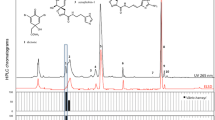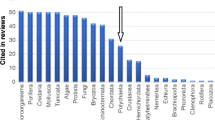Abstract
We used three chemical fractions (spanning a wide range of polarities) from the extracts of four marine invertebrates, the spongesCrambe crambe andHemimycale columella and the ascidiansCystodytes dellechiajei andPolysyncraton lacazei, to test inhibition of cell division, photosynthesis, and settlement. We used assay organisms from the same habitat, seeking to determine whether a species may display diverse, ecologically relevant bioac-tivities and, if so, whether the same types of compound may be responsible for such activities. Cell division was strongly inhibited by the spongeC. crambe. A dichloromethane fraction fromC. crambe prevented development of sea urchinParacentrotus lividus eggs at a concentration of 10 μg/ml, as did the butanolic fraction, but at higher concentrations (50 and 100 μg/ml). At 50 μg/ml, the aqueous fraction ofC. crambe allowed cell division but prevented eggs from developing beyond the gastrula stage. Similar results were recorded with the dichloromethane fraction ofP. lacazei and from the aqueous fraction ofH. columella. Photosynthesis was unaffected by any of the species at 50 μg/ml. Larval settlement was inhibited by one or another fraction from the four species surveyed at a concentration of 50 μg/ml, althoughC. crambe exhibited the greatest amount of activity. We therefore found that various fractions displayed the same type of bioactivity, while compounds from the same fraction were responsible for multiple activities, suggesting that secondary metabolites are multiple-purpose tools in nature, which is relevant to our understanding of species ecology and evolution. Moreover, results showed that the assessment of the role of chemical compounds is significantly influenced by the assay organism, fractionation procedure, concentration, and duration of experiments. All these factors should be carefully considered when testing ecological hypotheses of the roles of chemically-mediated bioactivities.
Similar content being viewed by others
REFERENCES
BECERRO, M. A. 1994. Chemically mediated bioactivity of the encrusting spongeCrambe crambe and its ecological consequences. PhD thesis. University of Barcelona.
BECERRO, M. A.,LÓPEZ, N. I.,TURON, X., andURIZ, M. J. 1994. Antimicrobial activity and surface bacterial film in marine sponges.J. Exp. Mar. Biol. Ecol. 179:195–205.
BECERRO, M. A.,TURON, X., andURIZ, M. J. 1995. Natural variation of toxicity in the encrusting spongeCrambe crambe (Schmidt) in relation to size and environment.J. Chem. Ecol. 21:1931–1946.
BERLINCK, R. G. S.,BRAEKMAN, J. C.,DALOZE, D.,HALLENGA, K., andOTTINGER, R. 1990. Two new guanidine alkaloids from the Mediterranean spongeCrambe crambe.Tetrahedron Lett. 31:6531–6534.
BERLINCK, R. G. S.,BIFULCO, G.,BRAECKMAN, J. C.,BRUNO, I.,DALOZE, D.,PEM, S.,RICCIO, R.,SPAMPINATO, S., andSPERONI, E. 1992a. Strong Ca++ channel blocker activity of crambescidin 816, a cytotoxic guanidine alkaloid from the marine spongeCrambe crambe.In 7th International Symposium on Marine Natural Products, Capri, Italy.
BERLINCK, R. G. S.,BRAEKMAN, J. C.,DALOZE, D.,BRUNO, I.,RICCIO, R.,ROGEAU, D., andAMADE, P. 1992b. Crambines C1 and C2: Two further ichthyotoxic guanidine alkaloids from the spongeCrambe crambe.J. Nat. Prod. 55:528–532.
BHAKUNI, D. S., andJAIN, S. 1990. Bioactive molecules of the marine invertebrates. Part I: Sponges, jelly fish, sea anemones, corals, and bryozoans.J. Sci. Ind. Res. 49:330–349.
CARIELLO, L.,GIUDICI, M., andZANETTI, L. 1980. Developmental aberrations in the sea-urchin eggs induced by avarol and two congeners, the main sesquiterpenoid hydroquinones from the marine spongeDysidea avara.Comp. Biochem. Physiol. 65:37–41.
CLARE, A. S. 1996. Marine neutral products antifoulants: status and potential.Biofouling 9:211–229.
COLL, J. C. 1992. The chemistry and chemical ecology of octocorals (Coelenterata, Anthozoa, Octocorallia).Chem. Rev. 92:613–631.
COLL, J. C.,PRICE, I. R.,KONING, G. M., andBOWDEN, B. F. 1987. Alga overgrowth of alcyonacean soft corals.Mar. Biol. 96:129–135.
CRONIN, G.,LINDQUIST, N.,HAY, M. E., andFENICAL, W. 1995. Effects of storage and extraction procedures on yields of lipophilic metabolites from the brown seaweedsDyctiota ciliolata andD. menstrualis.Mar. Ecol. Prog. Ser. 119:265–273.
DAVIS, A. R.,TARGETT, N. M.,MC CONNELL, O. J., andYOUNG, C. M. 1989. Epibiosis of marine algae and benthic invertebrates: natural products chemistry and other mechanisms inhibiting settlement and overgrowth, pp. 85–114,in P. J. Scheuer (ed.). Bioorganic Marine Chemistry, Vol. 3. Springer-Verlag, New York.
DINNEL, P. A.,LINK, J. M., andSTOBER, Q. J. 1987. Improved methodology for a sea urchin sperm biossay for marine waters.Arch. Environ. Contam. Toxicol. 16:23–32.
FAULKNER, D. J. 1994. Marine natural products.Nat. Prod. Rep. 11:355–394.
HARVELL, C. D., andFENICAL, W. 1989. Chemical and structural defenses of Caribbean gorgonians (Pseudopterogorgia spp.): Intracolony localization of defense.Limnol. Oceanogr. 34:382–389.
HAY, M. E., andSTEINBERG, P. D. 1992. The chemical ecology of plant-herbivore interactions in marine versus terrestrial communities, pp. 371–413,in G. A. Rosenthal and M. R. Berenbaum (eds.). Herbivores: The Interactions with Plant Metabolites, Vol. II. Academic Press, New York.
HAY, M. E.,KAPPEL, Q. E., andFENICAL, W. 1994. Synergisms in plant defense against herbivores: Interactions of chemistry, calcification, and plant-quality.Ecology 75:1714–1726.
JACKSON, J. B. C. 1979. Morphological strategies of sessile animals, pp. 499–555,in G. Larwood and B. R. Rosen (eds.). Biology and Systematics of Colonial Organisms. Academic Press, London.
JARES-ERIJMAN, E. A.,SAKAI, R., andRINEHART, K. L. 1991. Crambescidins: New antiviral and cytotoxic compounds from the spongeCrambe crambe.J. Org. Chem. 56:5712–5715.
KEOUGH, M. J. 1984. Kin-recognition and the spatial distribution of larvae of the bryozoanBugula neritina (L.).Evolution 38:142–147.
KOBAYASHI, J.,CHENG, J.,WALCHLI, M. R.,NAKAYAMA, H.,HIRATA, Y.,SASAKI, T., andOHIZUMI, Y. 1988. Cystodytins A, B and C, novel tetracyclic aromatic alkaloids with potent antineoplastic activity from the Okinawan tunicateCystodytes dellechiajei.J. Org. Chem. 53:1800–1804.
MAIDA, M.,CARROL, A. R., andCOLL, J. C. 1993. Variability of terpene content in the soft coralSinularia flexibilis (Coelenterata, Octocorallia) and its ecological implications.J. Chem. Ecol. 19:2285–2296.
MANKER, D. C., andFAULKNER, D. J. 1996. Investigation of the role of diterpenes produced by marine pulmonatesTrimusculus reticulatus andT. conica.J. Chem. Ecol. 22:23–35.
MARTIN, D., andURIZ, M. J. 1993. Chemical bioactivity of Mediterranean benthic organisms against embryos and larvae of marine invertebrates.J. Exp. Mar. Biol. Ecol. 173:11–27.
MINALE, L.,RICCIO, R., andSODANO, G. 1974. Avarol, a novel sesquiterpenoid hydroquinone with a rearranged drimane skeleton from the spongeDysidea avara.Tetrahedron Lett. 38:3401–3404.
PAUL, V. J. 1992. Ecological Roles of Marine Natural Products. Comstock, Ithaca, New York.
PAUL, V. J., andVAN ALSTYNE, K. L. 1988. Chemical defense and chemical variation in some tropical Pacific species ofHalimeda (Halimedaceae, Chlorophyta).Coral Reefs 6:263–269.
PAUL, V. J,LINDQUIST, N., andFENICAL, W. 1990. Chemical defenses of the tropical ascidianAtapozoa sp. and its nudibranch predatorsNembrotha spp.Mar. Ecol. Prog. Ser. 59:109–118.
PAWLIK, J. R.,ALBIZATI, K. F., andFAULKNER, D. J. 1986. Evidence of a defensive role for limatulone, a novel triterpene from the limpetCollisella limatula.Mar. Ecol. Prog. Ser. 30:252–260.
PAWLIK, J. R.,BURCH, M. T., andFENICAL, W. 1987. Patterns of chemical defense among Caribbean gorgonian corals: a preliminary survey.J. Exp. Mar. Biol. Ecol. 108:55–66.
PAWLIK, J. R.,CHANAS, B.,TOONEN, R. J., andFENICAL, W. 1995. Defenses of Caribbean sponges against predatory reef fish. I. Chemical deterrency.Mar. Ecol. Prog. Ser. 127:183–194.
PORTER, J. M., andTARGETT, W. M. 1988. Allelochemical interactions between sponges and corals.Biol. Bull. 175:230–239.
REISH, D. L., andOSHIDA, P. S. 1987. Manual of methods in aquatic environment research. Part 10. Short-term statistics bioassays.FAO Fish. Tech. Pap. 247:269.
ROSENTHAL, G. A., andBERENBAUM, M. R. 1992. Herbivores: Their Interaction with Secondary Plant Metabolites, 2nd ed., Vol. II. Evolutionary and Ecological Processes. Academic Press, San Diego, California.
RYLAND, J. S., andWARNER, G. F. 1986. Growth and form in modular animals: Ideas on the size and arrangement of zooids.Phil. Trans. R. Soc. London Ser. B313:53–76.
SAMMARCO, P. W., andCOLL, J. C. 1988. The chemical ecology of alcyonacean corals (Coelenterata: Octocorallia), pp. 87–116,in P. J. Scheuer (ed.). Bioorganic Marine Chemistry, Vol. 2. Springer-Verlag, New York.
SCHMITT, T. M.,HAY, M. E., andLINQUIST, N. 1995. Constraints on chemically mediated coevolution: Multiple functions for seaweed secondary metabolites.Ecology 76:107–203.
SCHUPP, P. J., andPAUL, V. J. 1994. Calcium carbonate and secondary metabolites in tropical seaweeds: variable effects on herbivorous fishes.Ecology 75:1172–1185.
SEBENS, K. P. 1987. The ecology of indeterminate growth in animals.Annu. Rev. Ecol. Syst. 18:371–407.
SEIBERT, G.,RAETHER, W.,DOGOVIC, N.,GASIV, M. J.,ZAHN, R. K., andMÜLLER, W. E. G. 1985. Antibacterial and antifungal activity of avarone and avarol.Zentralbl. Bekt. Hyg. 260:379–386.
STEINBERG, P. D., andVAN ALTENA, I. 1992. Tolerance of marine invertebrate herbivores to brown algal phlorotannins in temperate Australasia.Ecol. Monogr. 62:189–222.
TURON, X. 1988. Distribución ecológica de las ascidias de las costas de Catalunya e islas Baleares (Mediterráneo occidental).Misc. Zool. 12:219–236.
TURON, X. 1990. Distribution and abundance of ascidians from a locality on the northeast coast of Spain.PSZNI Mar. Ecol. 11:291–308.
TURON, X. 1992. Periods of non-feeding inPolysyncraton lacazei (Ascidiacea: Didemnidae): A rejuvenative process?Mar. Biol. 112:647–655.
TURON, X.,BECERRO, M. A.,LLOPIS, J., andURIZ, M. J. 1996a. Small-scale association measures in benthic communities as a clue for allelochemical interactions.Oecologia (Berlin) 108:351–360.
TURON, X.,BECERRO, M. A., andURIZ, M. J. 1996b. Seasonal patterns of toxicity in benthic invertebrates: The encrusting spongeCrambe crambe (Poecilosclerida).Oikos 75:33–40.
UNDERWOOD, A. J. 1981. Techniques of analysis of variance in experimental marine biology and ecology.Ocean Mar. Biol. Annu. Rev. 19:513–605.
URIZ, M. J. 1978. Contribución a la fauna de esponjas (Demospongia) de Cataluña e islas Baleares (Mediterráneo occidental).Misc. Zool. 11:291–308.
URIZ, M. J.,MARTIN, D., andROSELL, D. 1992a. Relationship of biological and taxonomic characteristics to chemically mediated bioactivity in Mediterranean littoral sponges.Mar. Biol. 113:287–297.
URIZ, M. J.,MARTIN, D., andROSELL, D. 1992b. The sponge population of the Cabrera archipielago (Balearic Islands): Characteristics, distribution and abundance of the most representative species.PSZNI Mar. Ecol. 13:101–117.
URIZ, M. J.,TURON, X.,BECERRO, M. A., andGALERA, J. 1996a. Feeding deterrence in sponges. The role of toxicity, physical defenses, energetic contents, and life-history stage.J. Exp. Mar. Biol. Ecol. 205:187–203.
URIZ, M. J.,BECERRO, M. A.,TUR, J. M., andTURON, X. 1996b. Location of toxicity within the Mediterranean spongeCrambe crambe (Demospongiae: Poecilosclerida).Mar. Biol. 124:583–590.
VAN ALSTYNE, K. L.,WYLIE, C. R., andPAUL, V. J. 1994. Antipredator defenses in tropical soft corals (Coelenterata: Alcyoncea). II. The relative importance of chemical and structural defenses in three species ofSinularia.J. Exp. Mar. Biol. Ecol. 178:17–34.
WAHL, M., andBANAIGS, B. 1991. Marine epibiosis. III. Possible antifouling defense adaptations inPolysyncraton lacazei (Giard) (Didemnidae, Ascidiacea).J. Exp. Mar. Biol. Ecol. 145:49–63.
WAHL, M., andLAFARGUE, F. 1990. Marine epibiosis. II. Reduced fouling onPolysyncraton lacazei (Didemnidae, Tunicata) and proposal of an antifouling potencial index.Oecologia 82:275–282.
WYLIE, C. R., andPAUL, V. J. 1989. Chemical defenses in three species of Sinularia (Coelenterata, Alcyonacea): Effects against generalist predators and the butterflyfishChaetodon unimaculatus Bloch.J. Exp. Mar. Biol. Ecol. 129:141–160.
YATES, J. L., andPECKOL, P. 1993. Effects of ambient availability and herbivory on polyphenolics in the seaweedFucus vesiculosus.Ecology 74:1757–1766.
Author information
Authors and Affiliations
Rights and permissions
About this article
Cite this article
Becerro, M.A., Turon, X. & Uriz, M.J. Multiple Functions for Secondary Metabolites in Encrusting Marine Invertebrates. J Chem Ecol 23, 1527–1547 (1997). https://doi.org/10.1023/B:JOEC.0000006420.04002.2e
Issue Date:
DOI: https://doi.org/10.1023/B:JOEC.0000006420.04002.2e




